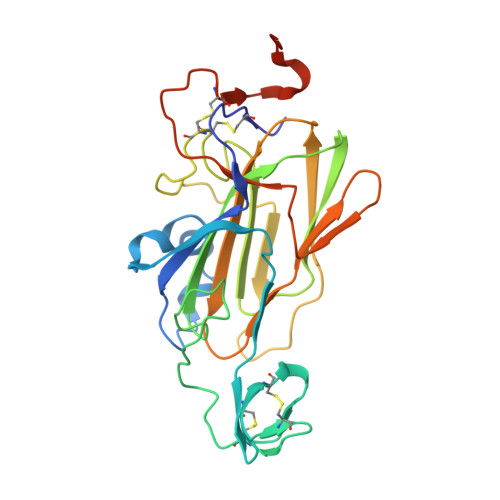Molecular mechanism of flocculation self-recognition in yeast and its role in mating and survival.
Goossens, K.V., Ielasi, F.S., Nookaew, I., Stals, I., Alonso-Sarduy, L., Daenen, L., Van Mulders, S.E., Stassen, C., van Eijsden, R.G., Siewers, V., Delvaux, F.R., Kasas, S., Nielsen, J., Devreese, B., Willaert, R.G.(2015) mBio 6: e00427-15
- PubMed: 25873380
- DOI: https://doi.org/10.1128/mBio.00427-15
- Primary Citation of Related Structures:
4LHK, 4LHL, 4LHN - PubMed Abstract:
We studied the flocculation mechanism at the molecular level by determining the atomic structures of N-Flo1p and N-Lg-Flo1p in complex with their ligands. We show that they have similar ligand binding mechanisms but distinct carbohydrate specificities and affinities, which are determined by the compactness of the binding site. We characterized the glycans of Flo1p and their role in this binding process and demonstrate that glycan-glycan interactions significantly contribute to the cell-cell adhesion mechanism. Therefore, the extended flocculation mechanism is based on the self-interaction of Flo proteins and this interaction is established in two stages, involving both glycan-glycan and protein-glycan interactions. The crucial role of calcium in both types of interaction was demonstrated: Ca(2+) takes part in the binding of the carbohydrate to the protein, and the glycans aggregate only in the presence of Ca(2+). These results unify the generally accepted lectin hypothesis with the historically first-proposed "Ca(2+)-bridge" hypothesis. Additionally, a new role of cell flocculation is demonstrated; i.e., flocculation is linked to cell conjugation and mating, and survival chances consequently increase significantly by spore formation and by introduction of genetic variability. The role of Flo1p in mating was demonstrated by showing that mating efficiency is increased when cells flocculate and by differential transcriptome analysis of flocculating versus nonflocculating cells in a low-shear environment (microgravity). The results show that a multicellular clump (floc) provides a uniquely organized multicellular ultrastructure that provides a suitable microenvironment to induce and perform cell conjugation and mating. Yeast cells can form multicellular clumps under adverse growth conditions that protect cells from harsh environmental stresses. The floc formation is based on the self-interaction of Flo proteins via an N-terminal PA14 lectin domain. We have focused on the flocculation mechanism and its role. We found that carbohydrate specificity and affinity are determined by the accessibility of the binding site of the Flo proteins where the external loops in the ligand-binding domains are involved in glycan recognition specificity. We demonstrated that, in addition to the Flo lectin-glycan interaction, glycan-glycan interactions also contribute significantly to cell-cell recognition and interaction. Additionally, we show that flocculation provides a uniquely organized multicellular ultrastructure that is suitable to induce and accomplish cell mating. Therefore, flocculation is an important mechanism to enhance long-term yeast survival.
Organizational Affiliation:
Department of Bioengineering Sciences, Structural Biology Research Center, Vrije Universiteit Brussel, Brussels, Belgium.
















